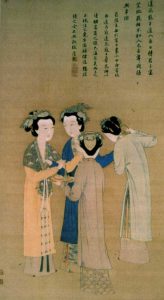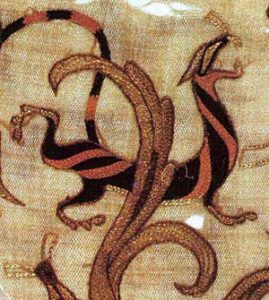
Ming dynasty (1400s AD) painting by Tang Yin
Tunics and padded jackets and pants
People in China generally wore tunics (like long t-shirts). Women wore long tunics down to the ground, with belts, and men wore shorter ones down to their knees. Sometimes they wore jackets over their tunics. In the winter, when it was cold, people wore padded jackets over their tunics, and sometimes pants under them.
Silk and hemp
In early China, poor people made their clothes of hemp or ramie, which is a plant like nettles. Rich people wore silk, and, like the women in this picture, they often wore more than one tunic, in layers.
Read more about hemp cloth
Read more about Chinese silk
All our China articles
During the Sui Dynasty, in the 500s AD, the emperor decided that all poor people had to wear blue or black clothes, and only rich people could wear colors. That didn’t last long though, as you can see from the picture of T’ang Dynasty farmers below.
More about the Sui Dynasty
Feather capes
In China’s version of the Cinderella story, her magic fish grants her a feather cape to wear to the Qingming Jie Spring Festival. I think that’s interesting because people also wore feather capes in the Americas.
Cherokee clothing
What were the hairstyles of ancient China?

Chinese clothing and hairstyles: Three farmers from T’ang Dynasty China, 700s AD
Most people in China, both men and women, wore their hair long. People said that you got your hair from your parents and so it was disrespectful to cut it.
Ancestor worship in China
Both men and women wore their hair up in a bun, fastened with wooden or ivory sticks. That kept your long hair out of your way.
What is ivory?
Did men shave their beards in ancient China?
Most men shaved their beards or grew a narrow beard on just their chin, but men in China often grew long mustaches.
When did Chinese embroidery get started?

Han Dynasty embroidery (200 BC-200 AD)
The invention of the steel sewing needle, about 200 BC, made it possible for the first time to do fine embroidery and fine sewing. The steel needles were so thin that they didn’t make big holes in the cloth.
More about needles and embroidery
So from the Han Dynasty onward, rich people liked to show off by having a lot of embroidery all over their clothes.
Did people in ancient China get tattoos?
Most people in ancient China thought tattoos were terrible, for the same reason that they didn’t cut their hair: because you got your body from your parents and it was disrespectful to change it. In China, people thought of tattoos as something foreigners did, like people from Central Asia or from Vietnam.

Chinese village doctor treating a man by burning herbs on his back (Song Dynasty, ca. 950 AD., now in National Palace Museum, Taiwan) – or is the doctor trying to remove the man’s tattoos?
Tattoos may have become more common in the Han Dynasty when the new steel needles were invented. But when people in China did get tattoos, it was often because somebody forced them to.
More about Central Asian clothing
Chinese government officials and slave-owners sometimes tattooed criminals and enslaved people. Tattoos were a way of shaming people and marking them as property. Under the Song Dynasty, the army also tattooed draftees and prisoners of war. Apparently some people used moxibustion – burning bundles of herbs on your skin – to try to get rid of the tattoos.
More about moxibustion
On the other hand, some people did want to get tattoos. Soldiers sometimes got tattoos of Chinese characters with strong messages like “Serve loyally.” And in some Chinese stories, men do have big colored tattoos of dragons and fairies, though other people look down on them for it.
(More about tattoos in medieval China)

X-ray pictures of someone with bound feet and a diagram
Foot-binding in medieval China
In the Song Dynasty, about 1100 AD, a fashion started at the emperor’s court for women to bind their feet. Women thought that to be beautiful they needed little tiny feet, only about three inches long. They got these tiny feet by wrapping tight bandages around the feet of little girls, about five or six years old.
Song Dynasty clothing

An embroidered shoe for someone with bound feet
The bandages were so tight they broke the girls’ toes and bent them underneath their feet and then they had to walk on them like that. The girls spent most of their time crying for two or three years and then the feet stopped hurting so much. Women with bound feet couldn’t walk very well at all, and when they had to work in the fields often they would crawl.
Cinderella and bound feet
Some early versions of the story of Cinderella come from Song Dynasty China. In these versions, the point of the story is that the Prince loves Cinderella because she has the smallest feet of any girl in the kingdom, so the slipper will only fit her.
Read the Chinese Cinderella story
Foot-binding and child labor
But bound feet weren’t really all about beauty. Many families chose to bind girls’ feet because bound feet forced young girls to sit still all day, and then they would spin and weave more cloth for the family to sell. Making cloth was a way families could get money for food and rent, so foot-binding was popular for that reason too.
Read more about the Chinese economy
A video about foot-binding
Cotton comes to China
Then in the Yuan Dynasty, the Mongols brought cotton to China. At first people didn’t want to grow cotton, maybe because the people running the silk industry wanted to keep people buying silk. But the Mongol invasions in the 1200s destroyed a lot of the mulberry trees that were needed to make silk.
The Mongols in China
The Mongol emperors, like Kublai Khan, turned to cotton to fill the gap. In 1289 AD they ordered the opening of special training centers to teach farmers how to grow cotton. And in 1296 they ordered that farmers who grew cotton could pay lower taxes.
History of cotton
Soon everyone liked cotton better than ramie or hemp. Cotton was warmer, and softer, and stronger, and cheaper. You could make it thin for summer, or you could make thick padded clothes out of it that were warm for winter.
Looking for tips for costumes of different periods? Check out these pictures of what women wore in each Chinese dynasty.
Learn by doing: check out some hemp clothing in a store
Later Chinese Clothing
Bibliography and further reading about ancient Chinese clothing:
China and Japan (Cultures and Costumes), by Paula Hammond (2003). For teens.
Moonbeams, Dumplings & Dragon Boats: A Treasury of Chinese Holiday Tales, Activities & Recipes, by Nina Simonds and others (Children’s Museum of Boston, 2002).
Chinese Clothing: An Illustrated Guide, by Valery Garrett (1994). Expensive, but there’s a lot of pictures. Some of it deals with a time period later than this site.
5000 Years of Chinese Costumes, by Zhou Xun and Gao Chunming (1987). This is for theater costumers and historians, and really goes into detail, with great pictures – but it’s not cheap. Get it through your library.
Bound, by Donna Jo Napoli (2004). A novel for young adults about footbinding in medieval China.





Do you know anything about the clothing Artisans and merchants wore in ancient China especially during the Tang Dynasty?
I’m not really an expert in this area, but you might look at some of the books recommended at the end of the article.
too many ads, didn’t help with my project.
Sorry! If you’d like to ask your questions here, I’d be happy to answer them. We’re thinking of removing all the ads and just relying on Patreon to support the site – stay tuned!
This was very helpful for my school project. Thank You!
Very interesting and disturbing. Humans are strange.thank you for information!
HI, this was very helpful for my project.
I assume that people started wearing clothes to protect themselves from the elements and it eventually became a custom that everyone was expected to follow, and first with religion there was a perceived element of modesty or morality.
In some countries, like Thailand, where it never was the custom, it quickly became one after exposure to “the West”.
But in other countries, where they interacted less with the West – China? -why did they start wearing clothes?
Hmm. People probably started to wear things as a matter of ornamentation and prestige, but yes, they got a lot more serious about it when they went north and it got cold in the winter. Clothing remained very expensive, and lots of people didn’t have any, or had very little. Children, for example, in warmer climates and from poor families, often didn’t have any clothes. And there’s very little taboo on male nudity in ancient Greece, for example. But people have been wearing clothes in China and Thailand for ten thousand years, long before they had contact with the West. That’s why they call it the Silk Road – because the West was importing Chinese silk cloth. It gets cold in northern China, so people wore clothes there because of the weather.
my name is jeff thenk you for tihs articel ok thenk you good job thenks you fammilie
too many ads!
Sorry, but that’s what pays for me to write these articles! Stay tuned for a premium paid option with no ads at all, and additional secret-just-for-premium-subscribers study tips and projects, coming soon.
Helpful, helped me out on my history project!
Nice! Much Helpful!
This. Is. NOICE!
video is disturbing
Indeed! Foot-binding was a horrible thing to do to people! But is it that different from, say, wearing very high heels today?
Wow! This is great!
thanks! I’m glad you liked it.
this helped me in my history project alot and great work on the vid it was awesome
I’m happy to hear it, Mister! I hope your project turns out great!
Thank you for that comment, I am doing a history projecto too
Extreamly helpful
Thank you!